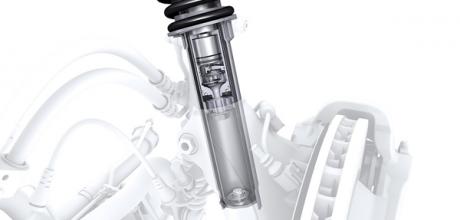Porsche Active Suspension Management explained

First introduced on the Porsche 911 997 Carrera S in 2005, Porsche Active Suspension Management (PASM) was created to give the best of both worlds at the press of a button, to the driver’s choosing: maximum comfort, or maximum dynamics.
Technology explained PASM
To understand the technology, we must step back and look at how suspension works. At its core, a suspension’s job is to keep the tyres on the road. In doing so, it has to both smooth out imperfections in the road’s surface, and control the vehicle’s behaviour when driving, from steady, high-speed motorway cruising, to heavy braking or evasive manoeuvres. For a 911, that means in a high-performance fashion, too, with a rear-weighted car design. Suspension uses two key components: springs (or torsion bars in 911s up to 1989) and dampers. Springs even out the vertical body movement generated by road imperfections, while dampers meter uncontrolled spring movement through the movement of hydraulic fluid inside the damper under resistance. Spring and damper rates are selected at fixed values, and this is the art of suspension tuning. Porsche engineers achieve a balance of performance and comfort for each 911, blending comfort and sporting dynamics. Their skill is to pick a setup that isn’t overly firm for road use, but not too soft for the high-performance, rear-engined 911 in spirited track driving. Until PASM.
PASM permits the damping rate to be varied, between two user-chosen settings, riding on 10mm lower springs than the Carrera. Introduced as ‘two cars in one’, the softer Normal mode aims to give standard ride comparable with a regular setup, while Sport mode intends to offer a firmer, sporting drive. PASM achieves this thanks to four dampers whose damping rates are continuously adjusted by internal bypass valves that are electronically controlled. This permits the damping force (not spring rate, which is fixed, note) to be either stiffened or softened as the PASM map commands. Sensors measuring everything from vertical body movement, lateral acceleration, steering angle, road speed, brake operation and engine speed feed that information into the PASM control module, and vary damping force as the PASM map dictates.
While there are two settings, there’s crossover between the two. As road speed increases, the PASM map will stiffen the dampers, and likewise, if road imperfections over a set parameter are detected, it softens the damper attitude, even in Sport mode, increasing passenger comfort. Likewise, brake sharply or change direction quickly and PASM detects this movement, firming damping as needed – regardless of programme – to prevent nose dive, or increase control. As such, a 911 in Normal mode may incrementally be at Sport mode values in certain conditions, or a Sport PASM setting may soften temporarily.

